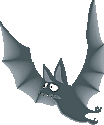|
On this page :
Leeches and snails
Birds nests
Guano
Adaptation
------------
LEECHES and SNAILS
I have never seen any leeches in Malaysian caves. This leech was found in a cave in NE Laos. It was named as Haemadipsa cavatuses (Borda, Elizabeth & Siddall, Mark E. (2010) Insights into the evolutionary history of Indo-Pacific bloodfeeding terrestrial leeches (Hirudinida : Arhynchobdellida : Haemadipisdae). Invertebrate Systematics, 2010, 24, 456–472). There is little documentation on cave leeches generally as they seem to be quite rare.
Snails on the other hand have been very well studied and documented from Malaysian limestone areas. But this Lao snail (on the right) is special to me..... On the 2006 expedition to Luang Nam Tha province in NW Laos, I collected some snails. Wim J.M.Maassen of the National Museum of Natural History, Leiden in The Netherlands kindly identified them for me, and found 4 new species. One of them he named after me, Sinoennea lizae , which was quite an honour for me.
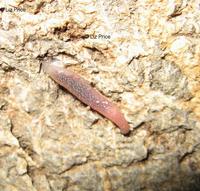
leech Haemadipsa cavatuses |
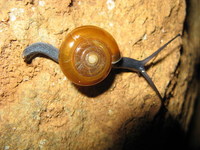
Perlis snail |
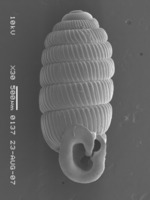
Sinoennea lizae from Laos |
Some snails in Malaysia are endemic to specific hills. These include 2 on Bukit Tenggek in Pahang, which is being quarried by YTL. They are Hypselostoma elephas and Plectostoma tenggekensis. See more on my blog. Another endemic and critically endangered snail is Charopa kanthanensis found on Gunung Kanthan in Perak, this hill is being quarried by Lafarge. Lafarge provided a grant for scientists from University Malaysia Sabah and Rimba to study snails on 12 limestone hills in Perak, see Rimba. The results were published in ZooKeys on 4 July 2017. They found "122 species of land snails, of which 34 species were unique to one of the surveyed hills. We identified 30 species that are potentially new to science. The number of land snail species recorded at each hill ranged between 39 and 63 species.". This report also writes that "Charopa lafargei which previously presumed as endemic to Gunung Kanthan (Vermeulen and Marzuki 2014), is shown in our study to also occur on the limestone hills at the north of Kinta Valley."
BIRDS NESTS
There has been a trade in birds nests for hundreds of years. The two main producers of edible nests are Aerodramus maximus (black nests) and Aerodramus fuciphagus (white nests). It is their salivary cement that is the basis for the famous bird nest soup and other related products. The swiftlet nests are commonly found in caves in Borneo, and also on some islands. However in Peninsula Malaysia, edible nest swiftlets don't seem to roost in limestone caves, though they do use sea caves. The Aerodramus genus of swiftlets are able to echolocate.
The demand for birds' nest products is still big, especially in Asia. Cave nests are still very popular. However within Malaysia many buildings are being converted into "swiftlet hotels". These can be old houses which are converted, or just normal shop houses where the upper floors are used for the birds. Even an old cinema has been converted. The windows and doors are removed and covered to prevent sunlight entering, leaving small holes for the birds to enter and exit. Recordings of the bird calls are played constantly through speakers to lure more birds. This is very noisy for human neigbours, who also have to put up with the stench of the bird droppings. In Sarawak some bird houses are made of wood and in the traditional style of a kampung house on stilts.
In 2006 there were an estimated 1,500 bird’s nest farmers just in Perak, with a total estimate of 30,000 "swiftlet hotels" in the country. Even in KL there appear to be swiftlet houses. According to the NST in March 2008, Kelantan is the country's second largest producer of nests, after Perak, with over 300 farms. The report went on to say that there were more than 36,000 farms throughout the country by the end of 2006. Malaysia is currently the world's third largest producer of edible birds' nests with 7% of gross supply value behind Indonesia (60%) and Thailand (20%). I've even seen an ad for a seminar on swiftlet farming.
By 2008 there were 50,000 swiftlet farms in Peninsula Malaysia. The export value from swiftlet farming in the country has reached around RM2 billion a year (Borneo Post 15 April 2009). Indonesia however still dominates the market for production of nests. By end 2010 there were an estimated 5,000 swiftlet houses in Sarawak. By Sept 2011 there were 1271 registered swiftlet houses in Johor.
COST:
In 2007 the cost of a kilo of nests ranged from RM4,000 to RM5,900, depending on quality. By mid 2009 nests can sell for up to US$2,700 (RM9,450) a kilo (Star 23.8.09). Top quality processed nests can go for RM15,000 to RM25,000 per kilo. However according to the Daily Express in Dec 2009, Indonesian nest traders are willing to buy Sabah nests for between RM7,000 and RM8,000 per kg for the raw nests from man-made birdhouses, while the cave nests are bought for between RM3,000 and RM5,000 per kg. In the peninsula, unprocessed nests from bird houses were selling between RM3,600 and RM4,000 per kg, and the processed ones can fetch twice more, Bernama. The price in Oct 2012 is between RM4,000 and RM5,000 per kg for raw and unprocessed birds' nests.
With the retail price of birds' nests ever increasing, it is no wonder that entrepreneurs are willing to spend tens of thousands of ringgit to convert old, sometimes abandoned, buildings, into homes for swiftlets. The use of heritage buildings is detrimental to the building as in the closed environment moisture accumulates hastening up the decay of the building.
USE: The nests are sold dried, or else they are made into products such as drinks. Apparently the nests harvested from man-made swiftlet houses take only 30 minutes to cook, unlike the cave nests which take three to four hours to cook. Beauty products such as face masks, cleanser, and eye and bust serum, also an anti-ageing range are made from bird’s nest extract. Even spas are offering a variety of facials all containing birds' nest. However the export of birds nest products requires a permit from the Wildlife and National Parks Dept, even for a single item.
In July 2009 there was news about an apparent scam in which a group was selling 'lots' of properties in which bird’s nests were being cultivated. It seems everyone is jumping on the bandwagon and trying to make money from birds' nests.
Traditionally it is the Chinese who buy birds nest products, but in a Feb 2010 Bernama report a company is now trying to promote birds nests products to the Malays.
In Aug 2011 it was said that unscrupulous traders were selling fake nests or ones with high nitrate content that didn't meet safety standards. This caused the price to drop considerably. China banned the import of many birds nests from Malaysia and in July 2012 this ban also applied to nests into Hong Kong. This resulted in the prices dropping again, both in Malaysia and Indonesia.
The edible-nest Swiftlet (Aerodramus fuciphagus) and black-nest Swiftlet (Aerodramus maximus) are protected species under the Protection of Wildlife Act, 1972 and any export/ import of their nests requires a license from the Department of Wildlife and National Parks. This comes under the Protection of Wildlife (Amendment) Order 2003 which stipulates a payment of RM0.10 cent per gram or RM100 per kilogram for the import/ export licence. The licence to harvest birds' nests is RM200/year.
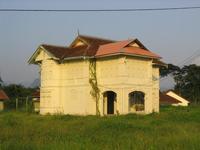
swiftlet house in Ipoh |
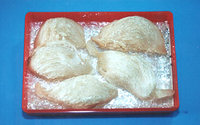
dried prepared nests |
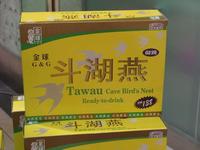
birds nest drink |
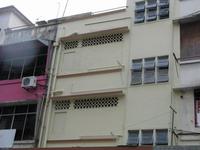
swiftlet house in Sandakan |
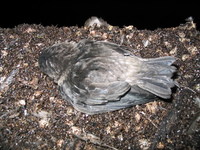
Gomantong swiftlet |
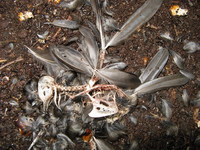
skeleton of swiftlet in Gomantong |
GUANO
Cave guano is the droppings of bats and swiftlets that accumulate on the floor of caves. The word guano comes from a Spanish word and was first used to define excrement from certain sea birds that had value to humans as a fertilizer. Now the word is also used to include the excrement of bats and swiftlets. Today guano is harvested from many caves in SE Asia, the USA, Cuba and S.America. It is a free source of nutrient rich fertilizer.
Cave guano is rich in nutrients as inside the cave there is no sunlight, wind or rain, and so the components don't break down as quickly as they would outside. As it is rich in nitrogen and phosphates, it is good for crops.
In caves with large populations of bats or swiftlets, the resulting guano piles can be many metres deep. The largest mound I have seen is in Gomantong Cave and was made famous by David Attenborough in the BBC film Caves in the Planet Earth series.
When manmade chemical fertilizers became readily available, guano was used less. However it has now regained its popularity as an organic fertilizer. There are many sites on the internet selling guano. But the indiscriminate harvesting of cave guano can upset the ecology of the caves, as the guano supports the whole cave food chain, and is home to many invertebrate species.
In Niah Caves, Sarawak, it is estimated that birds and bats have been producing guano for at least 100,000 years, and that 7-9m depth of guano has accumulated over that time. In fact this guano probably helped to preserve the famous ~40,000 year old human skull found in Niah. The thick sequences of guano have helped preserve many of the archaeological finds. At Niah the collecting of guano is allowed.
Today scientists are turning their attention to guano for other reasons. It is a source of palaeoenvironmental remains on glacial - interglacial timescales. This guano is now being studied to determine climatic changes over the past 10,000, even maybe 30,000 years. See dating cave samples.
See diseases related to guano.
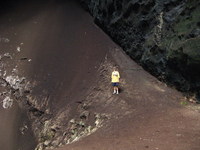
guano pile made famous by David Attenborough |
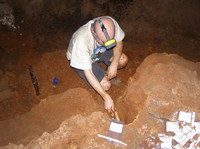
taking guano samples |
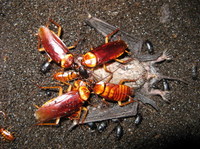
cockroaches feeding on dying bat |
ADAPTATION
It is widely thought that animals have special adaptations to be able to live in the total darkness of a cave. The most obvious of these are loosing the pigments and the eyes, as mentioned earlier, with the famous example of the Proteus salamander in Slovenia. However in tropical caves of SE Asia, this doesn't seem to happen much. Virtually all the tropical cave fauna has retained eyes and pigment, it is rare to find blind, white creatures. However one white troglobite is the cave crab, which is eyeless, and found in Mulu. But the Bidi Cave crabs (also in Sarawak) still have eyes and pigments. Other white AND eyeless Crustacea found in Mulu include Armadillo solumcolus, an isopod Cyathura sp., Bogidiella sarawacensis. The blind crabs along with these other crustacea, as well as some millipedes and pseudoscorpions are apparently the only troglobites without eyes. All the others have reduced eyes and pigments.
The cave racer snake in Peninsula Malaysia is a creamy white colour, but in Borneo it is a much darker grey colour with a more defined pattern, and yet it is thought to be the same species.
In caves with large populations of cockroaches, it is common to see white or cream coloured roaches. However these are simply the normal brown cockroaches which are undergoing a moult. This is the shedding of the exoskeleton in order to grow larger and the white colour darkens in a few hours.
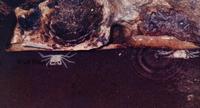
white crabs in Mulu |
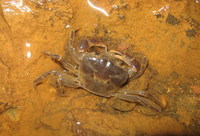
brown crab, Perlis |
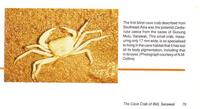
blind crab Mulu, photo from NM 15(3) 1990. |
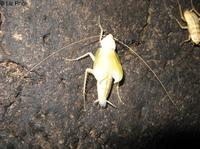
moulting cockroach |
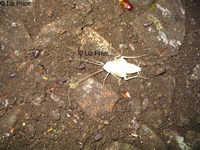
moulting cockroach |

|
© Liz Price 2007 - 2017
Page last updated July 2017 |
|
